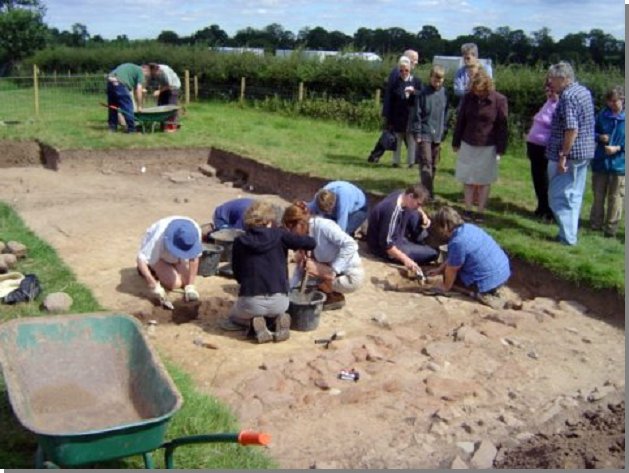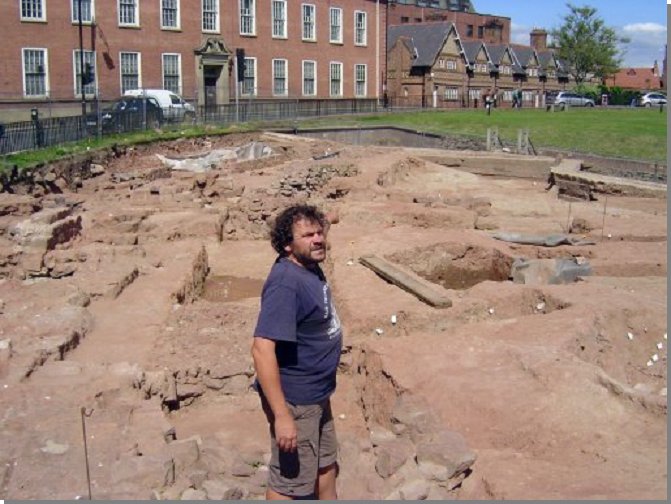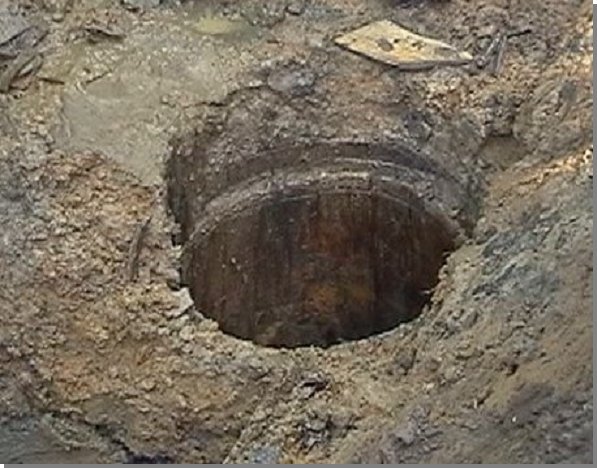 I
must admit I was just a little nervous about this year’s summer trip as the site at
Heronbridge was being closed down. It was going to be their last day, backfilling would be
in progress and the finds hut would probably be locked (to add to this the weather was
looking decidedly dodgy). My fears however were total unfounded, as, thanks to the members
of the Chester Arch Soc, it turned out to be a great day. Not only were trenches still
active, but a good selection of finds were on display and a comprehensive guided tour laid
on by society members (it also stayed fine all day). I
would like to express our gratitude, on behalf of all those who went, to George Storey,
Gina Muskett and Averil Downs for their efforts on the day and Pat Frost, the site
director, who organised it for us. I
must admit I was just a little nervous about this year’s summer trip as the site at
Heronbridge was being closed down. It was going to be their last day, backfilling would be
in progress and the finds hut would probably be locked (to add to this the weather was
looking decidedly dodgy). My fears however were total unfounded, as, thanks to the members
of the Chester Arch Soc, it turned out to be a great day. Not only were trenches still
active, but a good selection of finds were on display and a comprehensive guided tour laid
on by society members (it also stayed fine all day). I
would like to express our gratitude, on behalf of all those who went, to George Storey,
Gina Muskett and Averil Downs for their efforts on the day and Pat Frost, the site
director, who organised it for us.Heronbridge is a complex,
multi-period site, straddling the main road leading south out of Chester. Excavations have
been going on here since it was discovered in the 1920’s. The site is mainly Roman
consisting of roadside shops and workshops fronting the Roman Road, which underlies the
main road, but what makes it special is the activity that occurred just after the Roman
period. The evidence comes in the form of a huge Dark-age enclosure encompassing the area
between the main road and the River Dee on the east side. Its surrounding bank overlies
the Roman remains and also conceals a war grave holding an estimated 200 bodies. This
grave has recently been confirmed to be associated with the Battle of Chester when, in 616
AD, the combined British forces of Powys and Gwynedd were defeated by the English army of
Aethelfrith of Northumbria. (He is also said to have slain several hundred monks in the
process who had come to pray for the British side.) The enclosure, built just after of the
battle, is quite unique for that period. One theory is that the nearby river crossing was
strategically important and needed protection, hence the huge defence work. The current
work of the Chester Society involves finding out the full extent of these defences and
also how far the Roman settlement extends to the south of them.
http://www.chesterarchaeolsoc.org.uk/heronbridge.html
Amphitheatre
After a pleasant picnic on the banks of the Dee we made our way to the centre of Chester
for our amphitheatre visit. Dan Garner who organised it for us was not on site that day,
but instead, we had the great pleasure of a guided tour from Tony Wilmott, his
co-director.
This is their second season of excavations on the site and important new discoveries have
already been made. Earlier in the year Dan had explained how they had discovered two
phases to the amphitheatre with huge outer walls associated with each phase. Between these
walls, sand from the arena had accumulated, uniquely preserving evidence for Roman
‘match-day’ activity outside the first phase arena (e.g. chicken bones from fast
food stalls). Tony was now able to show us the latest finds including a series of huge
half-column bases surrounding the outer wall, a multicoloured shrine and most spectacular
of all (Tony was quite excited about this), fossilised wooden framework (in 3D) from the
internal seating. Tony is also very hopeful about the area “over the convent
wall”. This area has been out of bounds while the convent was in use so a full
sequence of archaeology is likely to have survived. What has been uncovered so far is
complex and difficult to interpret; a lot of activity seems to be associated with the
nearby St John’s Abbey, including walling and a formal garden. There is also evidence
of Civil War activity, when the Parliamentarians set up a siege cannon behind a wall to
try to breach the City walls. The evidence for this is in the form of misshapen lead
bullets, collected from the base of the wall, from the action on this emplacement. The
unexcavated area over the arena may provide the greatest potential; however so far, the
excavators have only reached down to the 17th century levels.
http://www.chester.gov.uk/amphitheatre/../../index.html
After the tour there was some free time for us to wander round the City walls or have a
beer in one of the riverfront bars, all in all a great day out.
 Well! Well! Well! Well! Well! Well!
Last month we also ventured down to the Greatacre site in Wigan to investigate the
report of a buried lead coffin (Newsletter 84). Allan Jennings was a lad when his father
came across it, two metres down, while digging for a well. We didn’t discover a
coffin but what we did find was a bit of a surprise - two wood-lined wells, one Victorian,
the other much later, together with a cache of old footwear (Click
here for full report ) .
Next Meeting
Wednesday 7th September at the Baden Powell Centre (Scout HQ) in
Greenough Street, starting at 7.30 pm as usual. This month, because we had Jack Smith in
June, we have brought in a new speaker at short notice. Susan Williams, a
post-graduate student from Liverpool University, has very kindly agreed to speak to us
about her recent work in Turkey. This was part of a University project on
a Roman Aqueduct at Oylum in eastern Turkey. Sounds fascinating - hope to
see you there. B.A.
|



